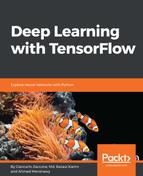Keras is a minimalist, high-level neural networks library, capable of running on top of TensorFlow. It was developed with a focus on enabling easy and fast prototyping and experimentation. Keras runs on Python 2.7 or 3.5, and can seamlessly execute on GPUs and CPUs given the underlying frameworks. It is released under the MIT license.
Keras was developed and maintained by François Chollet, a Google engineer, following these design principles:
- Modularity: A model is understood as a sequence or a graph of the standalone, fully configurable modules that can be plugged together with as few restrictions as possible. Neural layers, cost functions, optimizers, initialization schemes, and activation functions are all standalone modules that can be combined to create new models.
- Minimalism: Each module must be short (few lines of code) and simple. The source code should be transparent upon the dirt reading.
- Extensibility: New modules are simple to add (as new classes and functions), and existing modules provide examples. To be able to easily create new modules allows for total expressiveness, making Keras suitable for advanced research.
- Python: No separate model configuration files in a declarative format. Models are described in Python code, which is compact, easier to debug, and allows for ease of extensibility.
The following screenshot shows the Keras homepage:

The Keras home page
